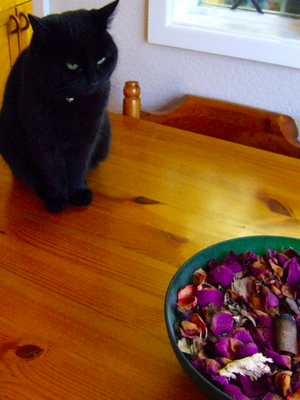
Potpourri is a mixture of scented dried plant materials made to perfume a space in the human home. It's a lovely way to bring nature into the home environment, to use natural materials to add both scent and colour to your living space.
The word potpourri comes from the French, which literally translates as rotten pot. However, don't let that put you off what is in actual fact a wonderful way to add fragrance to your home naturally! The original form of potpourri was not dried but moist and was hidden away inside a container because it was not considered worthwhile to look at; its real purpose was to emit pleasant odours to cover up the not-so-pleasant ones of less sanitary times.
In time, the dried version became more popular, allowing people to display pretty dried botanical items in the home, whilst still getting the benefit of the fragrance. Today, both types of potpourri can be made, depending on what you are seeking from the potpourri.
Moist potpourri[edit | edit source]
This method requires more effort than the dried potpourri version and, as noted already, is principally made for the fragrance and not for its display features. To create a moist potpourri, scented flowers are picked and partially dried. They are layered in a ceramic or glass jar, alternating with one layer of salt, one layer flowers, one layer of salt, and so on. It is left to change colour and crumble. When this occurs, fixatives such as orris root are added, along with chosen spices. Then the container is sealed and left to infuse for about two months. The mixture is tested for fragrance at the end of this time. If it's ready, then it can be transferred to a suitable potpourri container with holes that allow the scent to escape with ease.
Dried potpourri[edit | edit source]
There is less effort required to create dried potpourri, although sourcing the exact materials for it could take you a little while, depending on what's available to you. The natural material of scented flowers, cinnamon bark or rolls, citrus peels, seed pods, herbs, buds, etc. is collected, then dried thoroughly. If it is not dried thoroughly, it can grow mildew. A fixative is then added (usually orris root powder), then other fragrant elements can be added such as spices and essential oils. The items are mixed together, left in a covered container for around two weeks, then tested for readiness. If ready, the potpourri can be placed on open display in the home.
Natural items used in potpourri[edit | edit source]
Originally only flower petals were used in potpourris but this was expanded over time to include other items as well. Typical additions to potpourris include (and this is not an exhaustive list by any means):
- Lavender
- Rose
- Marigold
- Jonquils
- Jasmine
- Orange blossom
- Azalea
- Pittosporum
- Delphinium
- Daphne
- Honeysuckle
- Stock
- Carnation
- Lily of the valley
- Narcissus blossom
- Violets
- Lilac
- Leaves (eucalyptus, bay, verbena, pine, rosemary, scented pelargonium (geranium), thuja, pineapple sage, cupressus, citrus, etc.)
- Fern fronds and leaves
- Dried citrus peel (lemon, orange, etc.)
- Seed pods, especially large interesting pods, large seeds, gumnuts, etc.
- Twigs, fragrant wood shavings (such as huon pine), interesting wood shapes, etc. In some cases wooden craft cut-outs can be infused with oil and added.
- Spices such as cinnamon, cloves, coriander seeds, allspice, mace, nutmeg and ginger. These can be whole or ground, depending on the effect sought or the desire for scent to be released.
Wilted flower heads from flowers you've picked for indoor display can often be dried and added to potpourri for effect too.
If there is a special flower or floral arrangement that you'd like to keep longer, potpourri can be one option for preserving it for a time.
Fixative[edit | edit source]
A potpourri nearly always needs to have a fixative to extend the life of the fragrance. The most common fixative is that of orris root powder. This can be sourced from online stores and traders, craft stores and some pharmacies.
Essential oils can also be added to increase the fragrance. Rose, rose geranium and lavender are nice essential oil choices. It is also possible to use artificial fragrant oils but essential oils are preferred for their superior quality.
If the spices used are extremely strong in their own right, a fixative or enhancing oil may not be needed.
Displaying[edit | edit source]
Potpourri can be kept in containers especially designed for potpourri (these often come with ornate lids with hollowed out designs that allow for airflow), flat plates, trays, small shallow bowls, wide large bowls, sachets which allow the scent to pass through, and any other ideas you can come up with.
While the potpourri is pretty on display, it can be kept out of sight too, and still release its pleasant fragrance into the room.
Duration[edit | edit source]
Potpourri can be topped up with essential oil and new additions to mix in. However, in time it won't look as lovely as it once did and may indeed become a dust trap. At this point, return the plant items to the garden from where they came and consider making a new one.
Potpourri recipes[edit | edit source]
Potpourri recipes will added separately over time.